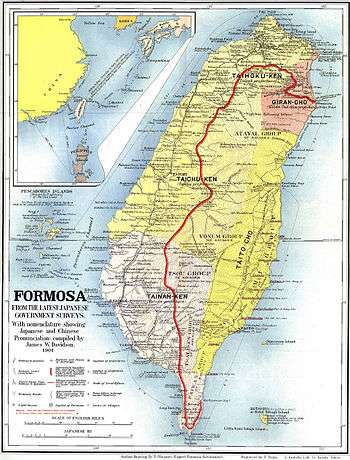Tsou people
The Tsou (Tsou: Cou; Chinese: 鄒; pinyin: Zōu; Wade–Giles: Tsou) are an indigenous people of central southern Taiwan. They are an Austronesian ethnic group. They are spread across two administrative entities of the Republic of China — Nantou County and Chiayi County.
Cou | |
|---|---|
 Photograph of Tsou hunters taken by Torii Ryūzō in 1900. | |
| Total population | |
| 6641 (January 2018) | |
| Regions with significant populations | |
| Languages | |
| Tsou, Mandarin | |
| Religion | |
| Animism, Christianity | |
| Related ethnic groups | |
| Kanakanavu, Saaroa, Taiwanese Aborigines |
They are sometimes confused with the Thao people of Sun Moon Lake. In the year 2018 the Tsou numbered 6,641. This was approximately 1.19% of Taiwan's total Indigenous population, making them the seventh-largest indigenous group.[1]
History

The Tsou are traditionally based in the Alishan area. Their rich oral histories describe migrations of each ancient clans' ancestors into the area between Yushan and the Chianan Plain. Originally, each clan had its own settlement, with the first multi-clan town, Tfuya, forming approximately 1600 CE.[2]
The earliest written record of the Tsou dates from the Dutch occupation, which describes the multi-clan settlement Tfuya as having approximately 300 people in 1647. Ethnologists have attempted to reconstruct the development of Tfuya, proposing that each stage of clan migration could be equivalent to three or four generations of family.[2] Another Formosan group of Bunun origin called the Takopulan reportedly lived in the same area, but were absorbed by the Tsou. Their largest settlement had 450 people in 1647. During the Japanese colonial period, four Tsou groups were recorded: Tfuya, Tapangᵾ, Imucu and Luhtu.[2]
Notable Tsous
- Francesca Kao, actress, singer and television host. Her native name is Paicʉ Yatauyungana.
- Tang Lanhua (湯蘭花), Taiwanese singer and actress. Her native name is Yurunana Daniiv.
- Tibusungu 'e Vayayana, Deputy Minister of the Council of Indigenous Peoples
See also
- Tsou language
- Taiwanese aborigines
References
- "2018年1月台閩縣市原住民族人口數". Council of Indigenous Peoples. 2018-02-07. Retrieved 2018-03-06.
- Hung, Ling-yu; Ho, Chuan-ko (2007), "New light on Taiwan highland prehistory", Bulletin of the Indo-Pacific Prehistory Association, 26: 21–31, doi:10.7152/bippa.v26i0.11990
| Wikimedia Commons has media related to Tsou people. |